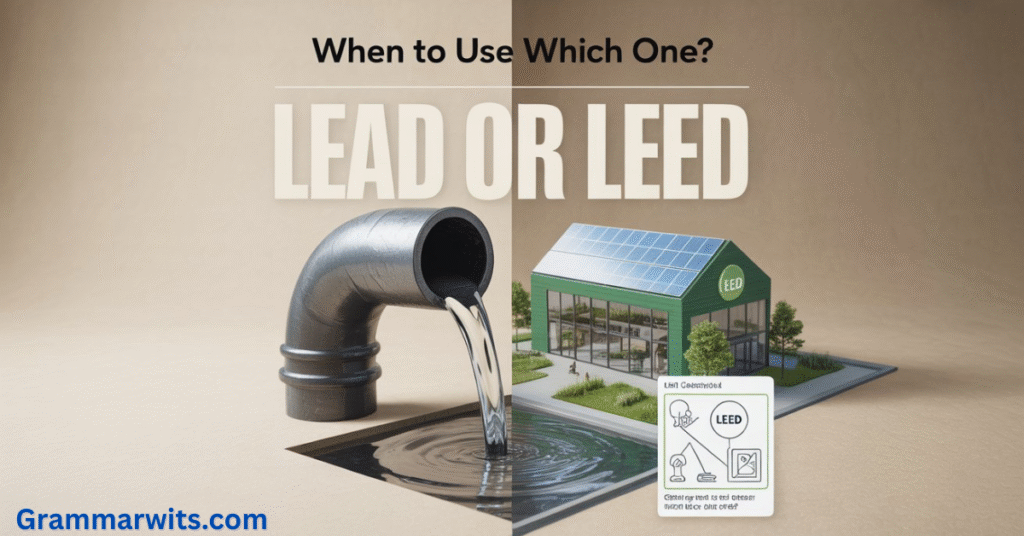Lead or LEED: When to Use Which One refers to understanding the clear distinction between two similar-sounding terms with very different meanings. “Lead” can signify a heavy metal, a guiding action, or a potential sales contact. On the other hand, “LEED” is an acronym for Leadership in Energy and Environmental Design, a globally recognized green building certification. Knowing how and when to use each is essential for clear communication in writing, design, and business.
In today’s fast-paced world of construction, architecture, marketing, and language, confusion between “lead” and “LEED” can affect credibility. Whether you’re crafting professional documents, writing online content, or discussing green building strategies, clarity matters. This topic simplifies their meanings and proper usage so you can write with confidence and precision.
Understanding Lead or LEED: When to Use Which One will empower you to speak accurately in multiple industries. From sustainable design to sales funnels and metal applications, this guide covers it all with simple breakdowns and real-world examples.
The Core Difference: Lead vs LEED Explained
Lead: The Multifaceted Powerhouse
Lead carries multiple meanings that span centuries of human civilization. As a metal lead, it’s the dense, toxic element with symbol Pb that Romans used for plumbing systems. The word “plumbing” actually derives from “plumbum,” Latin for lead.
When we discuss lead in leadership, we’re talking about guidance, direction, and authority. A team leader doesn’t just manage—they guide others toward shared goals. This usage evolved from the physical act of leading someone down a path.
Lead in sales represents potential customers or business opportunities. Sales professionals generate sales leads through various marketing channels. These customer opportunities form the lifeblood of revenue generation across industries.
The pronunciation remains consistent: /liːd/ with a long ‘e’ sound, regardless of context.
LEED: The Green Revolution Standard
LEED (Leadership in Energy and Environmental Design) represents a comprehensive green certification system developed by the U.S. Green Building Council (USGBC). This acronym always appears capitalized because it’s a proper noun referring to a specific certification program.
LEED certification evaluates buildings across multiple environmental sustainability criteria. These include energy efficiency, water conservation, indoor environmental quality, and renewable energy integration. The system awards points based on performance in each category.
LEED in architecture has revolutionized how designers approach sustainable building practices. Architects now consider passive solar heating, rainwater harvesting, and low-VOC paints as standard design elements rather than optional features.
The pronunciation matches “lead” exactly: /liːd/, creating the confusion that necessitates this guide.
Historical Context: How These Terms Evolved
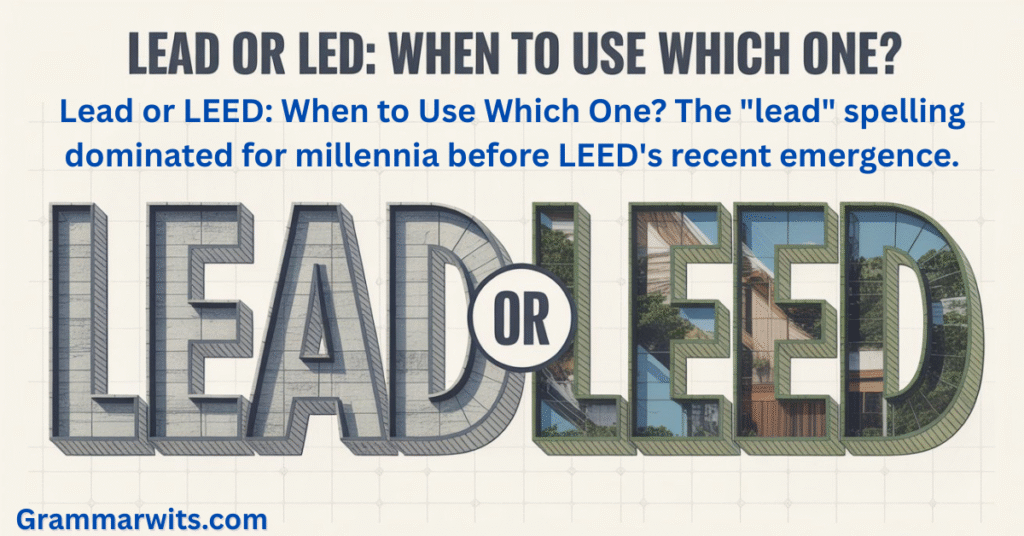
Lead’s Ancient Journey
The word “lead” traces back to Old English “lēad,” with roots in Germanic languages. Ancient civilizations prized this malleable metal for its durability and workability. Romans extensively used lead for pipes, paint, and even wine sweetening—unknowingly poisoning themselves in the process.
The leadership meaning emerged through metaphorical extension. Just as lead’s density made it sink and “lead” other materials downward, leaders guide their followers forward. This connection between physical properties and abstract concepts demonstrates language’s fascinating evolution.
Lead or LEED: When to Use Which One? The “lead” spelling dominated for millennia before LEED’s recent emergence.
LEED’s Modern Genesis
The U.S. Green Building Council founded LEED in 1993, responding to growing environmental concerns in construction. The first LEED system launched in 2000, establishing baseline standards for eco-friendly construction.
LEED emerged from collaborative efforts between architects, engineers, and environmental scientists. They recognized that buildings consume 40% of global energy and generate 36% of carbon emissions. LEED certification became the solution for measurable environmental design improvements.
The timing proved perfect. Climate change awareness was rising, and the construction industry needed standardized green building metrics. Lead or LEED: When to Use Which One? This question only became relevant after 2000.
Usage Rules: When Each Term Applies
Lead Usage Scenarios
Lead meaning varies dramatically based on context, but patterns emerge for professional communication:
- As Metal Applications:
- Environmental remediation discussions
- Manufacturing safety protocols
- Recycled materials specifications
- Toxicity assessments and health reports
2. As Leadership Contexts:
- Management role descriptions
- Project direction documentation
- Team guidance strategies
- Taking charge of initiatives
3. As Sales Terminology:
- Marketing funnel descriptions
- Customer acquisition strategies
- Revenue generation reports
- Customer opportunities analysis
4. As Action Verbs:
- Process facilitation
- Team guidance
- Initiative direction
- Strategic planning
LEED Usage Requirements
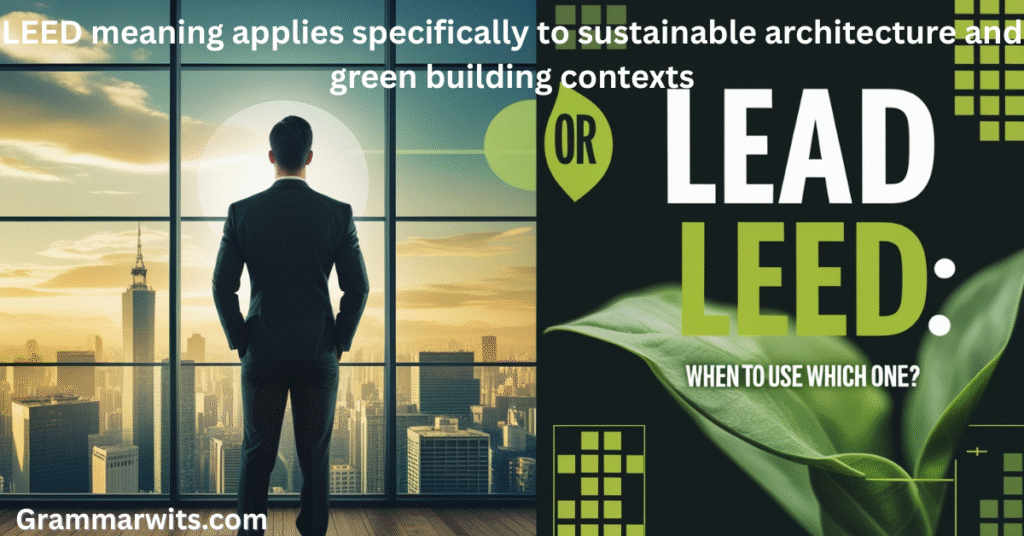
LEED meaning applies specifically to sustainable architecture and green building contexts:
Building Certifications:
- New construction projects
- Existing building renovations
- Retrofitting buildings for efficiency
- Energy-saving structures documentation
Sustainability Reporting:
- Corporate environmental goals
- Eco-conscious development metrics
- Renewable building standards compliance
- Smart cities planning initiatives
Architectural Documentation:
- Design specifications for LEED architects
- Sustainable materials selection
- Indoor air quality requirements
- Solar panels integration plans
Real Estate Marketing:
- Property value enhancement
- Tenant attraction strategies
- LEED building design showcases
- Eco-friendly building promotions
Industry-Specific Applications
Lead in Different Sectors
Construction Industry Applications:
The construction sector deals with metal lead primarily through safety regulations. Lead paint removal requires specialized protocols and certified professionals. Lead or LEED: When to Use Which One? In construction safety documents, always use “lead” when discussing the toxic metal.
| Lead Safety Requirement | Compliance Standard | Health Impact |
|---|---|---|
| Paint removal protocols | EPA RRP Rule | Prevents lead poisoning |
| Worker protection gear | OSHA standards | Reduces exposure risks |
| Dust containment systems | HUD regulations | Protects building occupants |
| Soil testing procedures | State environmental laws | Prevents contamination |
Healthcare Sector Usage:
Healthcare professionals focus on lead toxicity prevention and treatment. Lead poisoning remains a significant public health concern, particularly affecting children in older buildings.
Sales and Marketing Applications:
Modern sales teams rely heavily on lead generation strategies. Digital marketing creates sales leads through content marketing, social media engagement, and search engine optimization.
LEED Across Industries
Commercial Real Estate Excellence:
LEED-certified buildings command premium rents and attract environmentally conscious tenants. Studies show LEED buildings achieve 3-7% higher rents and 4-10% higher sale prices compared to conventional properties.
Educational Facilities Innovation:
Schools pursuing LEED certification create healthier learning environments. Indoor environmental quality improvements include better ventilation, natural lighting, and low-VOC paints that reduce harmful emissions.
Healthcare Buildings Transformation:
Hospitals implementing LEED in architecture principles report improved patient outcomes. Water conservation systems, energy efficiency measures, and enhanced air quality contribute to healing environments.
Retail Spaces Evolution:
Retailers adopting sustainable building practices strengthen brand reputation and reduce operating costs. LEED building design attracts eco-conscious consumers and demonstrates corporate responsibility.
Common Mistakes and How to Avoid Them
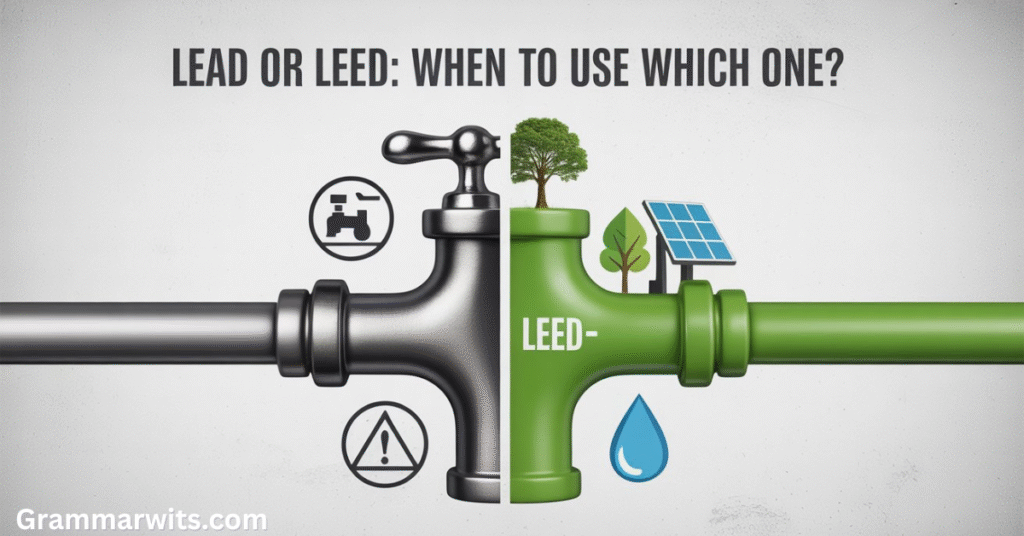
Professional Writing Errors
Capitalization Confusion:
Never capitalize “lead” when referring to metal lead or lead in leadership. These are common nouns requiring standard capitalization rules. Only capitalize “LEED” because it’s an acronym for a specific certification system.
Context Misapplication:
Lead or LEED: When to Use Which One? Context determines everything. Environmental documents discussing building standards require “LEED,” while safety documents about toxic materials need “lead.”
Plural Form Mistakes:
- Sales leads (multiple customer opportunities)
- LEED points (certification scoring system)
- Lead pipes (multiple plumbing components)
- LEED projects (multiple certified buildings)
Industry-Specific Confusion
Construction Documentation Issues:
Construction professionals frequently mix terminology in project specifications. Sustainable materials requirements belong in LEED sections, while metal lead safety measures appear in environmental health protocols.
Marketing Materials Problems:
Marketing teams sometimes use “lead” when promoting eco-friendly building features. This undermines credibility and confuses potential clients seeking green certification information.
Context Clues: Quick Decision Framework
Choose “Lead” When:
Discussing Toxic Materials:
- Metal lead contamination
- Environmental safety protocols
- Health risk assessments
- Regulatory compliance documentation
Describing Leadership Roles:
- Taking charge of projects
- Guiding others through challenges
- Management responsibilities
- Strategic direction setting
Referring to Sales Opportunities:
- Customer opportunities generation
- Marketing funnel development
- Revenue pipeline management
- Business development strategies
Using as Action Verbs:
- Project facilitation
- Team guidance
- Initiative direction
- Process leadership
Choose “LEED” When:
Discussing Green Building:
- LEED certification processes
- Sustainable architecture principles
- Environmental design standards
- Green building regulations
Referencing Sustainability:
- Energy efficiency improvements
- Water conservation systems
- Renewable energy integration
- Indoor air quality enhancements
Describing Environmental Design:
- Eco-friendly construction methods
- Sustainable materials selection
- LEED architects involvement
- Green certification requirements
Mentioning USGBC Programs:
- U.S. Green Building Council initiatives
- LEED system updates
- Renewable building standards evolution
- Environmental sustainability metrics
Real-World Examples and Case Studies
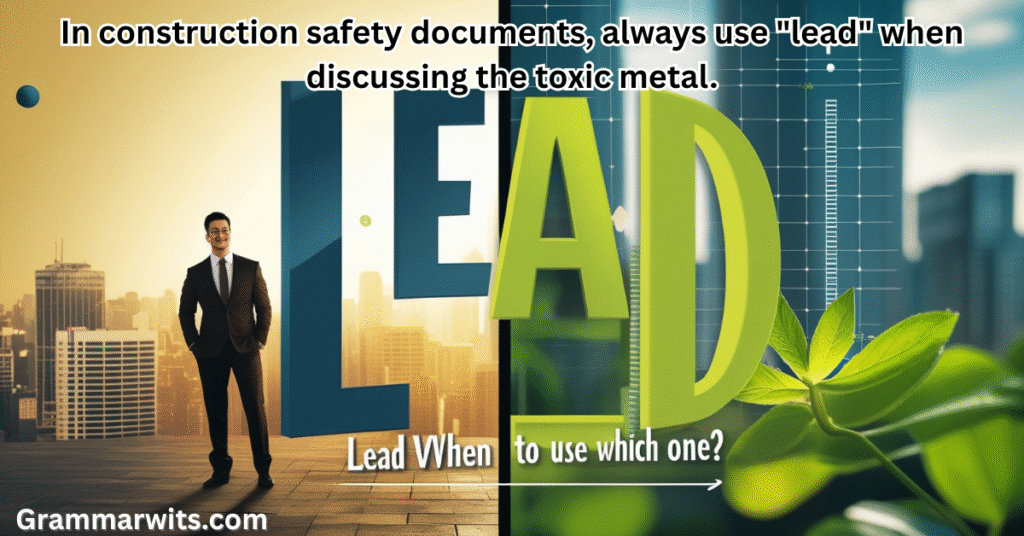
Lead Success Stories
Corporate Leadership Excellence:
Tesla’s lead in leadership within the electric vehicle industry demonstrates how companies can guide entire sectors toward sustainability. Their approach to taking charge of innovation has inspired traditional automakers to accelerate electric vehicle development.
Sales Excellence Achievement:
HubSpot’s lead generation strategies have helped thousands of businesses improve their customer opportunities conversion rates. Their inbound marketing methodology transforms how companies attract and nurture sales leads.
Safety Compliance Success:
The EPA’s metal lead removal protocols have significantly reduced childhood lead poisoning cases. These comprehensive safety measures protect workers and building occupants during lead paint remediation projects.
LEED Implementation Wins
Microsoft’s Redmond Campus Achievement:
Microsoft’s headquarters campus achieved LEED Platinum certification through innovative sustainable building practices. The project incorporates solar panels, rainwater harvesting, and advanced energy efficiency systems.
| LEED Category | Points Earned | Key Features |
|---|---|---|
| Energy Efficiency | 35/37 | Smart building systems, LED lighting |
| Water Conservation | 11/11 | Rainwater collection, low-flow fixtures |
| Indoor Environmental Quality | 14/16 | Natural ventilation, low-VOC paints |
| Sustainable Materials | 12/14 | Recycled materials, local sourcing |
Bank of America Tower Innovation:
This Manhattan skyscraper became one of the first LEED Platinum office buildings in New York City. The building features passive solar heating, advanced air filtration, and renewable energy systems.
Google’s Mountain View Campus:
Google’s headquarters demonstrates LEED in architecture excellence through net-zero energy goals. The facility integrates solar panels, energy-saving structures, and sustainable materials throughout its design.
Lead or LEED: When to Use Which One? Google’s project clearly required “LEED” when discussing their green building achievements.
Future Trends and Considerations
Lead’s Evolving Landscape
Regulatory Tightening:
Environmental regulations continue restricting metal lead usage across industries. The construction sector increasingly adopts lead-free alternatives for plumbing and paint applications.
Digital Leadership Transformation:
Lead in leadership concepts evolve with remote work trends. Leaders now guide others through digital platforms, requiring new skills in virtual team management and online communication.
Sales Technology Integration:
Lead generation strategies increasingly rely on artificial intelligence and machine learning. These technologies improve customer opportunities identification and conversion rates.
LEED’s Growing Influence
International Expansion:
LEED certification programs now operate in over 160 countries. The U.S. Green Building Council continues expanding green building standards globally.
Smart Building Integration:
LEED architects increasingly incorporate Internet of Things (IoT) technologies. These smart cities innovations optimize energy efficiency and indoor environmental quality automatically.
Climate Change Response:
LEED system updates reflect urgency around climate change mitigation. New standards emphasize renewable energy, carbon neutrality, and resilient design principles.
Lead or LEED: When to Use Which One? Future building projects will increasingly require LEED considerations as environmental concerns intensify.
Actionable Takeaways
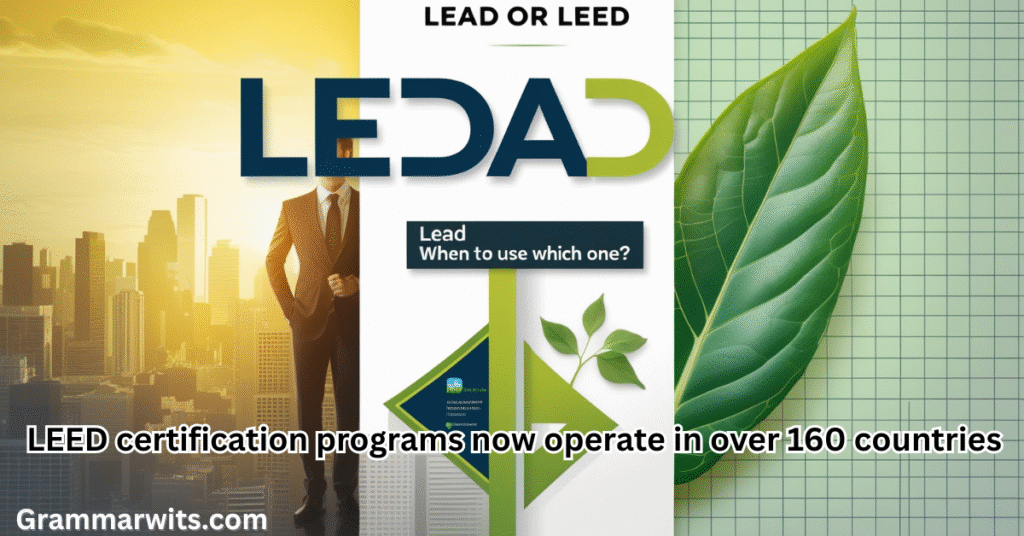
For Professionals
Proofreading Excellence:
Create standardized checklists for document review. Include specific checks for lead vs LEED usage in relevant sections. Train team members on context-appropriate terminology.
Industry-Specific Guidelines:
Develop style guides tailored to your industry’s needs. Sustainable architecture firms need different protocols than sales organizations focusing on lead generation.
Team Training Programs:
Implement regular training sessions on professional communication. Lead or LEED: When to Use Which One? This question should become automatic for your team members.
For Organizations
Communication Standards:
Establish clear protocols for LEED certification documentation versus metal lead safety reporting. Consistency builds credibility with clients and regulatory bodies.
Brand Consistency Maintenance:
Ensure marketing materials accurately reflect your green building capabilities or lead in leadership positioning. Terminology mistakes undermine professional credibility.
Compliance Documentation:
Maintain separate systems for environmental sustainability reporting and lead safety protocols. This prevents dangerous cross-contamination of critical information.
Comprehensive FAQ Section
Q1: Can a building have both lead concerns and LEED certification?
Absolutely. Many LEED-certified buildings required metal lead remediation during renovation. The LEED system actually encourages addressing environmental hazards as part of sustainable building practices. Lead or LEED: When to Use Which One? In this scenario, you’d use both terms appropriately based on context.
Q2: How do I remember which spelling to use in professional documents?
Focus on context clues. Green building, energy efficiency, and sustainable architecture discussions require “LEED.” Metal lead safety, lead in leadership, and sales leads contexts need “lead.” Lead or LEED: When to Use Which One? Ask yourself whether you’re discussing environmental certification or other topics.
Q3: Are there different LEED certification levels I should know about?
Yes, LEED certification includes four levels: Certified (40-49 points), Silver (50-59 points), Gold (60-79 points), and Platinum (80+ points). Each level reflects increasing environmental sustainability achievement in eco-friendly construction.
Q4: What are the most common industries where this confusion occurs?
Construction, real estate, architecture, and environmental consulting see the most lead vs LEED confusion. These industries work with both metal lead safety and green certification requirements regularly.
Q5: How does LEED certification impact property values and marketability?
LEED-certified buildings typically command 3-7% higher rents and 4-10% higher sale prices. They also experience faster tenant attraction and improved occupancy rates due to growing demand for eco-friendly building features.
Mastering the Distinction
Understanding Lead or LEED: When to Use Which One? separates professionals from amateurs in today’s competitive marketplace. The distinction reflects deeper knowledge of sustainable architecture, environmental design, and professional communication standards.
Lead encompasses metal lead safety, lead in leadership dynamics, and sales leads generation. Each application requires different expertise and regulatory understanding.
LEED represents the future of green building through sustainable building practices, energy efficiency, and environmental sustainability. The U.S. Green Building Council continues expanding these standards globally.
Master this distinction, and you’ll communicate with the precision that builds trust and credibility. Your professional reputation depends on getting these details right.
Lead or LEED: When to Use Which One? You now have the knowledge to make this decision confidently every time.

Alizy Smith is a passionate language enthusiast and the admin of Grammar Wits. With a love for wordplay, grammar quirks, and witty expressions, she’s dedicated to making language learning fun and accessible. From grammar tips to pun-filled laughs, Alizy ensures every piece of content entertains while educating — turning tricky rules into easy, enjoyable reads.
